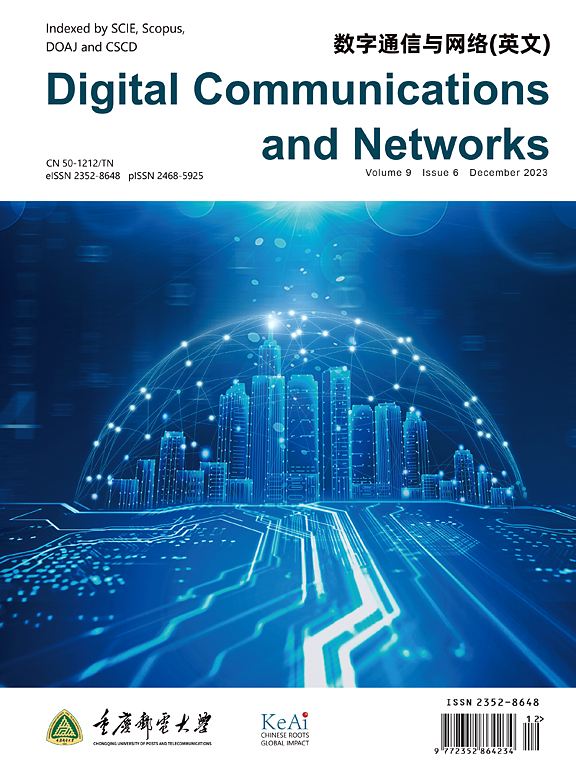Resource allocation algorithm for downlink secure transmission in wireless EH cooperative networks with idle relay-assisted jamming
IF 7.5
2区 计算机科学
Q1 TELECOMMUNICATIONS
引用次数: 0
Abstract
In wireless Energy Harvesting (EH) cooperative networks, we investigate the problem of secure energy-saving resource allocation for downlink physical layer security transmission. Initially, we establish a model for a multi-relay cooperative network incorporating wireless energy harvesting, spectrum sharing, and system power constraints, focusing on physical layer security transmission in the presence of eavesdropping nodes. In this model, the source node transmits signals while injecting Artificial Noise (AN) to mitigate eavesdropping risks, and an idle relay can act as a jamming node to assist in this process. Based on this model, we formulate an optimization problem for maximizing system secure harvesting energy efficiency, this problem integrates constraints on total power, bandwidth, and AN allocation. We proceed by conducting a mathematical analysis of the optimization problem, deriving optimal solutions for secure energy-saving resource allocation, this includes strategies for power allocation at the source and relay nodes, bandwidth allocation among relays, and power splitting for the energy harvesting node. Thus, we propose a secure resource allocation algorithm designed to maximize secure harvesting energy efficiency. Finally, we validate the correctness of the theoretical derivation through Monte Carlo simulations, discussing the impact of parameters such as legitimate channel gain, power splitting factor, and the number of relays on secure harvesting energy efficiency of the system. The simulation results show that the proposed secure energy-saving resource allocation algorithm effectively enhances the security performance of the system.
空闲中继辅助干扰下无线EH协同网络下行安全传输的资源分配算法
在无线能量采集(EH)协同网络中,研究了下行物理层安全传输的安全节能资源分配问题。首先,我们建立了一个包含无线能量收集、频谱共享和系统功率约束的多中继协作网络模型,重点关注存在窃听节点的物理层安全传输。在该模型中,源节点在传输信号的同时注入人工噪声(Artificial Noise, AN)来降低窃听风险,空闲中继可以作为干扰节点来辅助这一过程。在此模型的基础上,我们提出了一个最大化系统安全收集能量效率的优化问题,该问题集成了对总功率、带宽和an分配的约束。通过对优化问题进行数学分析,得出安全节能资源分配的最优解,包括源节点和中继节点的功率分配策略、中继节点之间的带宽分配策略和能量收集节点的功率分配策略。因此,我们提出了一种安全的资源分配算法,旨在最大限度地提高安全收获的能源效率。最后,我们通过蒙特卡罗模拟验证了理论推导的正确性,讨论了合法信道增益、功率分裂因子和继电器数量等参数对系统安全收集能量效率的影响。仿真结果表明,提出的安全节能资源分配算法有效地提高了系统的安全性能。
本文章由计算机程序翻译,如有差异,请以英文原文为准。
求助全文
约1分钟内获得全文
求助全文
来源期刊

Digital Communications and Networks
Computer Science-Hardware and Architecture
CiteScore
12.80
自引率
5.10%
发文量
915
审稿时长
30 weeks
期刊介绍:
Digital Communications and Networks is a prestigious journal that emphasizes on communication systems and networks. We publish only top-notch original articles and authoritative reviews, which undergo rigorous peer-review. We are proud to announce that all our articles are fully Open Access and can be accessed on ScienceDirect. Our journal is recognized and indexed by eminent databases such as the Science Citation Index Expanded (SCIE) and Scopus.
In addition to regular articles, we may also consider exceptional conference papers that have been significantly expanded. Furthermore, we periodically release special issues that focus on specific aspects of the field.
In conclusion, Digital Communications and Networks is a leading journal that guarantees exceptional quality and accessibility for researchers and scholars in the field of communication systems and networks.
 求助内容:
求助内容: 应助结果提醒方式:
应助结果提醒方式:


